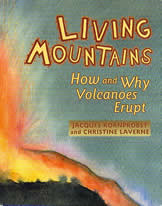
Living Mountains
How and Why Volcanoes Erupt
by Jacques Kornprobst and Christine Laverne
Living Mountains: How and Why Volcanoes Erupt
|
|
| CONSTRUCTING VOLCANOES |
1
|
| Simple and Complex Volcanoes |
1
|
| Lavas |
2
|
| Fluid Lavas: Flows and Lava Lakes |
3
|
| Pahoehoe Flows, 'A'a Flows, and Ropy Lavas |
3
|
| Lava Tunnels |
4
|
| Columnar Jointing |
5
|
| Viscous Lavas: Domes and Petaloid Flows |
8
|
| Simple Domes, Complex Domes, and Cryptodomes |
9
|
| Prismatic Columns in Viscous Lava |
11
|
| Volcanic Ejecta |
11
|
| Bombs, Lapilli, and Ash |
11
|
| Inclusions and Xenoliths |
12
|
| Pyroclastic Formations |
12
|
| Ignimbrites |
14
|
| Why Explosive Eruptions Occur |
15
|
| Volcanic Gases |
15
|
| Gas Expansion |
16
|
| Strombolian Eruptions and Lava Fountains |
17
|
| Plinian Eruptions |
20
|
| Pelean Eruptions |
20
|
| Surges |
23
|
| When Rising Magma Meets Groundwater |
23
|
| Carbonic Eruptions |
26
|
| Percolation of Carbon Dioxide through Earth's Crust |
26
|
| Disruption of Deep Aquifer Layers |
26
|
| Overturn of Water in Crater Lakes |
27
|
| The Effects of Volcanic Eruptions on Climate |
28
|
| Repose Period of a Volcano and Fumarolic Activity |
29
|
| Submarine Volcanoes: Eruptions beneath the Sea |
29
|
| Hyaloclastites |
30
|
| Pillow Lavas and Lava Ponds |
30
|
| Black Smokers |
33
|
| Volcanic Collapse |
34
|
| Lahars |
34
|
| Flank Slides |
35
|
| Calderas |
36
|
| WHERE MAGMA ORIGINATES |
38
|
| The Earth's Concentric Structure |
38
|
| Partial Melting of Rocks |
40
|
| Migration of a Melt |
42
|
| Formation of Magma Chambers |
42
|
| The Conditions of Partial Melting |
43
|
| Mantle Convection and Plate Tectonics |
44
|
| Seafloor Spreading |
45
|
| Subduction |
47
|
| Mantle Upwelling: Partial Melting due to Reduced Pressure |
47
|
| Formation of the Oceanic Crust |
48
|
| Hot Spot Volcanism |
49
|
| Subduction: Partial Melting due to the Addition of Water |
51
|
| Magma Pooling: Partial Melting due to Increased Temperature |
53
|
| VOLCANIC ROCK DIVERSITY |
55
|
| Cooling History |
55
|
| Obsidian |
56
|
| Microlitic and Doleritic Textures |
57
|
| Aphyric versus Porphyritic Texture |
58
|
| Chemical Diversity |
59
|
| Differences in Source Material and Degree of Partial Melting |
60
|
| Magma Mixing and Contamination |
61
|
| Bimodal Volcanism |
61
|
| Magma Mixing or Hybridization |
61
|
| Contamination |
62
|
| Magmatic Differentiation by Fractional Crystallization |
62
|
| Crystallization in a Magma Chamber |
64
|
| Unraveling a Lava's History |
67
|
| Trace Elements |
67
|
| Isotopic Ratios |
69
|
| DATING VOLCANIC EVENTS |
72
|
| History |
72
|
| Relative Chronology |
73
|
| Absolute Chronology |
74
|
| Carbon-14 Dating |
74
|
| Potassium-Argon Dating |
75
|
| Thermoluminescence |
76
|
| PREDICTING VOLCANIC ERUPTIONS |
78
|
| Estimating the Threat |
78
|
| Precursors of Eruptions |
79
|
| Seismic Precursors |
79
|
| Inflation of Volcanoes |
80
|
| Tilt Meters |
80
|
| Displacement Meters |
80
|
| Electronic Distance Meters |
81
|
| Spatial Altimetry |
81
|
| Thermal and Chemical Precursors |
82
|
| Magnetic Precursors |
83
|
| Volcano Surveillance Networks |
83
|
| Glossary |
89
|
| Index |
95
|
ADVERTISEMENT
